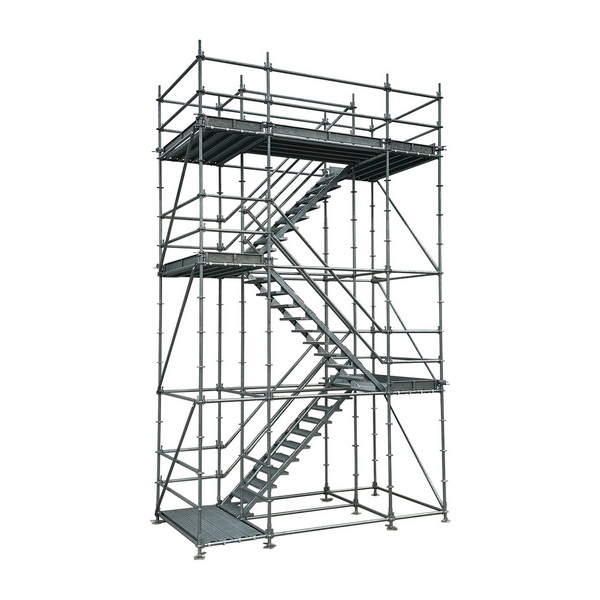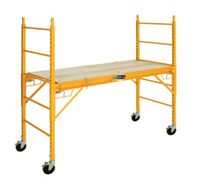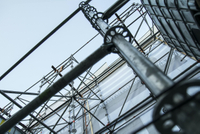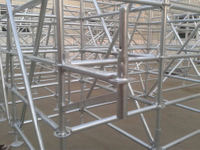Content Menu
● Introduction to Ringlock Scaffolding
● How Ringlock Scaffolding Works
● Advantages of Ringlock Scaffolding for Residential Construction
>> 1. Flexibility and Adaptability
>> 2. Enhanced Safety
>> 3. Rapid Assembly and Dismantling
>> 4. Cost-Effectiveness over Time
>> 5. Durability in Various Weather Conditions
● Common Residential Applications
● Considerations and Challenges in Residential Settings
● Comparing Ringlock Scaffolding to Other Systems in Residential Use
● Cost Aspects of Using Ringlock Scaffolding in Residential Projects
>> Initial Costs
>> Labor Costs
>> Long-Term Value
● Maintenance and Safety in Residential Use
● Environmental Impact and Sustainability
● Conclusion
● FAQ
>> 1. Is ringlock scaffolding overkill for small residential projects?
>> 2. Can ringlock scaffolding be installed by a small crew?
>> 3. How does ringlock scaffolding improve worker safety on residential sites?
>> 4. Is ringlock scaffolding reusable for multiple residential projects?
>> 5. What is the typical rental vs purchase cost trade-off for residential use?
Ringlock scaffolding has gained tremendous popularity in modern construction projects across the globe, prized for its modular design, robustness, and speed of assembly. While it is widely used in large-scale industrial and commercial ventures, many professionals and homeowners alike wonder: Is ringlock scaffolding suitable for residential construction? This article explores the suitability of ringlock scaffolding specifically for residential building and renovation projects, analyzing its advantages, applications, considerations, and cost implications.

Introduction to Ringlock Scaffolding
Ringlock scaffolding is a modular scaffolding system featuring vertical standards equipped with pre-welded rosettes (circular nodes with multiple holes). This design allows multiple horizontal and diagonal components to connect securely via a wedge locking mechanism, enabling robust, flexible structures that can fit complex shapes and heights.
Originally developed for industrial and commercial use, ringlock scaffolding's adaptability is now gaining attention in residential construction and renovation projects because of its advantages over traditional scaffolding systems like tube-and-clamp or frame scaffolding.
How Ringlock Scaffolding Works
Ringlock scaffolding relies on the rosette locking technology:
- Each vertical standard bears rosettes at regular intervals.
- Horizontal ledgers, diagonal braces, transoms, and other components slot into these rosettes.
- A wedge locks the connection securely without the need for bolts or clamps.
This system provides stability, speed in assembly/disassembly, and versatile configurations including straight runs, corners, stair towers, cantilevered extensions, and curved layouts.
Advantages of Ringlock Scaffolding for Residential Construction
1. Flexibility and Adaptability
Residential buildings often have varying architectural features — balconies, irregular facades, multiple floor levels, and tight spaces. Ringlock scaffolding can easily adapt to straight, angular, and curved surfaces. Stair towers and cantilevers provide easy access to different elevations and challenging areas.
2. Enhanced Safety
Safety is vital during residential construction, often involving small teams working in constrained areas. Ringlock's high load-bearing capacity and secure locking mechanism reduce the risk of scaffold collapse or accidental disassembly. Its integrated guardrails, wide platforms, and anti-slip surfaces provide safe working conditions.
3. Rapid Assembly and Dismantling
Traditional scaffolding often requires nuts, bolts, or clamps, resulting in slow erection times. The ringlock system's slot-and-wedge design allows faster assembly — saving labor costs and meeting tight residential project schedules.
4. Cost-Effectiveness over Time
Although initial ringlock scaffolding investment may be higher than some traditional systems, its durability and reusability deliver significant value for contractors conducting multiple residential builds or renovations. Its modular nature means easy transport and storage, critical for smaller residential projects with space constraints.
5. Durability in Various Weather Conditions
Ringlock scaffolding components are typically hot-dip galvanized, offering resistance to corrosion. This means the scaffolding remains safe and functional across long periods, even outdoors on houses exposed to weather elements.
Common Residential Applications
Ringlock scaffolding suits various residential construction tasks:
- House painting and exterior finishing: Provides stable access to facades, eaves, and roofs.
- Home additions and extensions: Facilitates safe work at varying heights around extensions.
- Roof repairs and new construction: Offers secure platform installation for roofing teams.
- Window and door installation or replacement: Allows unobstructed access to wall apertures.
- Deck and balcony construction: Custom configurations fit complex balcony shapes.
- Chimney repairs: Easy to build circular scaffold around chimneys.
- Interior decoration and ceiling works: Can be used indoors for tall ceilings or retrofit projects.

Considerations and Challenges in Residential Settings
While highly versatile, ringlock scaffolding also poses challenges in residential use:
- Scale and Quantity: For very small projects, ringlock might feel over-engineered and costlier than simpler frame scaffolds.
- Access Restrictions: Residential sites with limited yard space or narrow streets may complicate delivery and on-site storage.
- Noise and Visual Impact: Ringlock scaffolding can be bulky, which might raise concerns in neighborhoods about aesthetics and disturbance.
- Skill Requirement: Proper assembly requires trained personnel, and inexperienced use risks compromising safety and structural integrity.
These factors necessitate weighing ringlock scaffolding benefits against project size, site conditions, budget, and timelines.
Comparing Ringlock Scaffolding to Other Systems in Residential Use
Feature |
Ringlock Scaffolding |
Frame Scaffolding |
Tube and Clamp Scaffolding |
Assembly Speed |
Fast (wedge-lock, modular) |
Moderate (clip or pin connections) |
Slow (requires bolting/clamping) |
Flexibility |
Very high (multi-angle, curves) |
Moderate (limited configurations) |
High (fully custom but laborious) |
Safety |
High stability and locking |
Moderate |
Depends on assembler skill |
Load Capacity |
High load-bearing capacity |
Moderate |
Variable depending on build |
Cost (Initial Investment) |
Higher upfront cost |
Lower |
Moderate to high |
Reusability and Lifespan |
Long lifespan with corrosion resistance |
Less durable |
Durable but complex maintenance |
Suitability for Small Jobs |
Suitable but potentially overkill |
Very suitable |
Flexible but labor-intensive |
Summary: Ringlock scaffolding shines in multi-level, complex residential projects requiring high safety and speed. Frame scaffolding may suffice for simple painting or minor repairs. Tube and clamp offers fully custom solutions but at higher labor costs.
Cost Aspects of Using Ringlock Scaffolding in Residential Projects
Initial Costs
- The cost depends on the size, height, and complexity of scaffolding needed.
- Component prices for ringlock scaffolding typically range as follows:
- Standards: $11–$88 each
- Ledgers: $18–$53 each
- Base plates: $11–$86 each
- Braces: $41–$56 each
- Rental is usually 5–15% of purchase price per month, ideal for short residential projects.
Labor Costs
- Labor savings due to rapid assembly reduce total project time and expenses.
- However, skilled labor is mandatory for safety and compliance, impacting labor rates.
Long-Term Value
- Hot-dip galvanized components withstand weathering, allowing repeated use across several projects.
- Durability and reduced maintenance reduce replacement costs, providing savings over time.
Maintenance and Safety in Residential Use
- Regular inspections ensure locking wedges and rosettes remain secure and undamaged.
- Rings and other components must be checked for deformation or corrosion, especially if reused outdoors.
- Adherence to building codes and scaffold safety regulations is mandatory.
- Training staff or contractors in correct ringlock assembly and dismantling enhances site safety.
Environmental Impact and Sustainability
Ringlock scaffolding's reuse, longevity, and corrosion resistance contribute positively to environmental sustainability:
- Reduced Waste: Unlike disposable or single-use scaffolding, ringlock systems are designed for multiple uses, reducing scrap metal waste.
- Efficient Transport and Storage: Modular design allows compact stacking, lowering transport-related emissions on multiple trips.
- Materials: Most ringlock scaffolding components are made from recyclable steel.
- Eco-Friendly Coatings: Advances in galvanizing technology reduce use of harmful chemicals during finishing.
This makes ringlock scaffolding an environmentally responsible choice for conscientious residential builders.
Conclusion
Ringlock scaffolding is indeed suitable and highly effective for residential construction projects, offering exceptional flexibility, strength, and safety compared to traditional systems. Its modular design allows adaptation to varied residential architectural demands, such as balconies, stairs, and curved facades. While it may involve a higher initial investment and require experienced labor, the long-term benefits of durability, rapid assembly, and enhanced safety make it an excellent choice, especially for medium to large-sized residential builds or renovations with complex structures.
Smaller or very simple residential projects might find frame scaffolding more cost-effective. Yet, as residential construction becomes more complex and safety standards more stringent, ringlock scaffolding is increasingly the go-to solution for professionals seeking efficiency and confidence to tackle a wide range of home construction challenges.

FAQ
1. Is ringlock scaffolding overkill for small residential projects?
Not necessarily, but for very minor works like single-story painting or window replacement, simpler scaffolding might be more cost-effective. Ringlock scaffolding truly shines in multi-level renovations or additions where flexibility and safety are critical.
2. Can ringlock scaffolding be installed by a small crew?
Yes, its modular design allows rapid assembly by a small experienced team, saving labor time. However, proper training is essential to ensure safe and correct installation.
3. How does ringlock scaffolding improve worker safety on residential sites?
Ringlock offers high load capacity, robust locking connections, integrated guardrails, and wide platforms with anti-slip surfaces, significantly minimizing risks compared to older scaffold types.
4. Is ringlock scaffolding reusable for multiple residential projects?
Absolutely. Its durable, galvanized steel structure is designed for multiple reuses, making it a cost-efficient investment for contractors handling several projects.
5. What is the typical rental vs purchase cost trade-off for residential use?
For short-term work, renting ringlock scaffolding at 5-15% monthly cost reduces upfront capital. For longer or multiple projects, purchasing is often more economical over time due to reuse and residual value.






















